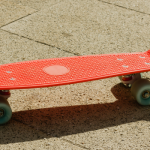Skateboard trucks, oh man, they’re like super important, you know? They’re this crucial component that connects the deck to the wheels, giving riders that sweet turning and maneuverability. And let me tell you, there’s a whole world of details behind how these trucks are made.
We’re talking about the materials, the manufacturing process, and the design elements that make them work like magic. So, in this guide, we’re gonna take you through all the steps, from start to finish, and give you a real deep understanding of these awesome skateboarding equipment. Let’s go!
Guide to Skateboard Trucks
Skateboard trucks consist of several parts, including the baseplate, hanger, axle, bushings, and kingpin. These components work together to determine the turning ability and stability of the skateboard. Let’s take a closer look at each part and how they come together to form a functional skateboard truck.
- Baseplate: The baseplate is the flat, metal plate that attaches the skateboard truck to the deck. It is typically made of aluminum, which provides a good balance of strength and weight. The baseplate is mounted to the skateboard deck using screws and acts as the anchor for the rest of the components.
- Hanger: The hanger is the T-shaped part of the truck that holds the axle and connects to the baseplate. Like the baseplate, the hanger is commonly made of aluminum. It plays a crucial role in determining how the skateboard turns, as it pivots on the kingpin. The width of the hanger affects the stability of the skateboard, with wider hangers providing more stability but less agility.
- Axle: The axle is a metal rod that runs through the hanger and holds the wheels in place. It is usually made of high-strength steel to withstand the forces and impacts encountered during skateboarding. The length of the axle determines the overall width of the skateboard trucks.
- Bushings: Bushings are small, cushion-like components that sit on either side of the hanger and play a crucial role in the turning mechanism of the skateboard. They are typically made of polyurethane and come in various durometers (hardness levels). Softer bushings allow for easier turning, while harder bushings provide more stability.
- Kingpin: The kingpin is a large bolt that holds the skateboard truck together. It runs through the hanger and baseplate, and it is tightened to adjust the tightness of the trucks. Looser trucks make turning easier, while tighter trucks provide more stability.
The Manufacturing Process
Manufacturing skateboard trucks involves a series of well-defined steps, each crucial to ensuring the quality, performance, and safety of the final product. Let’s break down each stage:
Step 1: Design
The process commences with the design phase:
- CAD Design: Engineers and designers utilize computer-aided design (CAD) software to create detailed 3D models of the skateboard trucks. This involves determining dimensions, shaping the components, and finalizing key features like the hanger’s geometry and kingpin placement.
Step 2: Material Selection
Choosing the right materials is vital for durability and performance:
- Baseplate and Hanger: Aluminum is commonly chosen for its lightweight and durable properties.
- Axle: Crafted from high-strength steel to withstand the stresses of riding and tricks.
Step 3: Casting
The hanger and baseplate are formed through the casting process:
- Melting Metal: The selected metal, often aluminum, is melted.
- Pouring into Molds: The molten metal is poured into molds shaped like the desired components.
- Cooling and Solidification: As the metal cools and solidifies, the molds are opened, revealing the rough form of the hanger and baseplate.
Step 4: Machining
The rough castings undergo precision machining to achieve the final shape:
- CNC Machines: Computer Numerical Control (CNC) machines are employed to carve out intricate details with precision.
- Refinement: This stage ensures uniformity and accuracy in the final shape and dimensions of the hanger and baseplate.
Step 5: Heat Treatment
Enhancing the strength and durability of metal components:
- Controlled Processes: The hanger and baseplate undergo controlled heating and cooling processes.
- Fortification: Heat treatment strengthens the metal, preparing it to withstand the rigors of skateboarding.
Step 6: Assembly
Bringing together the individual components to form a functional truck:
- Axle Insertion: The axle, typically made of steel, is inserted through the hanger.
- Adding Bushings and Kingpin: Polyurethane bushings are added on either side of the hanger, and the kingpin is integrated.
- Mounting on Deck: The assembled trucks are mounted onto the skateboard deck using screws.
Step 7: Quality Control
Ensuring the trucks meet stringent quality standards:
- Strength Testing: Components undergo tests to assess their strength.
- Assembly Check: Verify that all components are assembled correctly.
- Tolerance Verification: Ensure all elements meet specified tolerances.
- Safety Assurance: Rigorous checks are conducted to guarantee the safety and reliability of the skateboard trucks.
Key Design Considerations in Skateboard Trucks
Designing skateboard trucks involves a careful consideration of various elements that directly impact performance and rider experience. Let’s explore the methods behind key design considerations:
Geometry:
- Methodology: Engineers use advanced CAD software to manipulate the geometry of the hanger and baseplate.
- Analysis: Through simulation and analysis, designers study the effects of different kingpin angles and hanger shapes on turning responsiveness.
- Testing: Prototypes with varying geometries are manufactured and tested to assess real-world performance.
- Adjustment: Based on test results, adjustments are made to optimize the geometry for stability, turning capability, and responsiveness.
Bushing Shape and Durometer:
- Design Iteration: Designers experiment with various bushing shapes (conical, barrel, cone/barrel) using CAD tools.
- Material Selection: Different materials with varying durometers are tested for the bushings.
- Rider Feedback: Prototypes are tested by riders to gather subjective feedback on how each bushing shape and durometer combination feels during turns.
- Refinement: Based on rider feedback and performance metrics, the optimal bushing shape and durometer are selected.
Hanger Width:
- Market Research: Manufacturers analyze market trends and rider preferences to understand the demand for stability vs. agility.
- Rider Input: Collaboration with professional skateboarders and user surveys help gather insights into the ideal hanger width for different riding styles.
- Testing: Prototypes with varying hanger widths are manufactured and tested in different skateboarding scenarios.
- Data Analysis: Performance data, including stability and maneuverability metrics, is analyzed to determine the ideal hanger width for specific applications.
Kingpin Tightness:
- Adjustable Systems: Engineers design trucks with adjustable kingpin tightness, allowing riders to customize their setup.
- Testing: Riders experiment with different kingpin tightness settings, providing feedback on turning responsiveness.
- Data Collection: Sensors and instrumentation may be used to collect quantitative data on how different kingpin tightness settings affect turning angles and forces.
- User Preferences: Manufacturers consider rider preferences obtained from surveys and feedback to recommend default settings.
Material Quality:
- Material Testing: Rigorous testing is conducted on different aluminum alloys for the baseplate and hanger, as well as on high-strength steel for the axle.
- Quality Standards: Adherence to industry standards and specifications ensures the chosen materials meet durability and performance requirements.
- Prototyping: Initial prototypes are manufactured using selected materials to evaluate their performance under various stress conditions.
- Feedback Loop: Continuous feedback from testing informs any necessary adjustments to material specifications for optimal strength and durability.
Conclusion
Skateboard trucks are a fundamental component that significantly influences the overall performance and feel of a skateboard. From the selection of materials to the intricacies of design and manufacturing processes, the creation of skateboard trucks involves a blend of engineering precision and an understanding of skateboarders’ diverse preferences.
As riders continue to push the boundaries of what is possible on a skateboard, manufacturers will likely explore innovative materials and design concepts to enhance performance and durability. Whether you’re a seasoned skateboarder or a newcomer to the sport, understanding the intricacies of skateboard trucks can deepen your appreciation for the craftsmanship behind this essential piece of skateboarding equipment.
![Why do skateboarders hate scooters? [Reasons + Tips] Why do skateboarders hate scooters? [Reasons + Tips]](https://bedoper.site/wp-content/uploads/2023/04/Why-do-skateboarders-hate-scooters-150x150.png)


![How fast do skateboards go downhill? [90 mph (145 km/h)] How fast do skateboards go downhill? [90 mph (145 km/h)]](https://bedoper.site/wp-content/uploads/2023/04/How-fast-do-skateboards-go-downhill-150x150.png)
